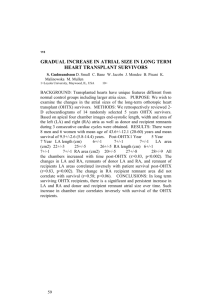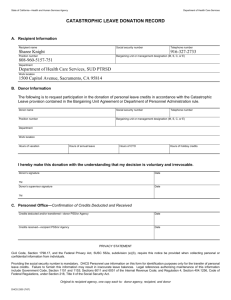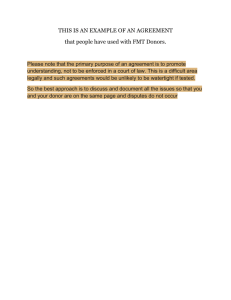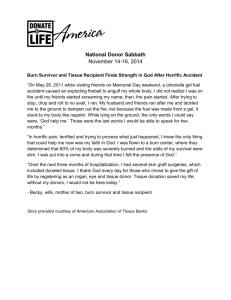9. recipient strategies for continued collaboration
advertisement
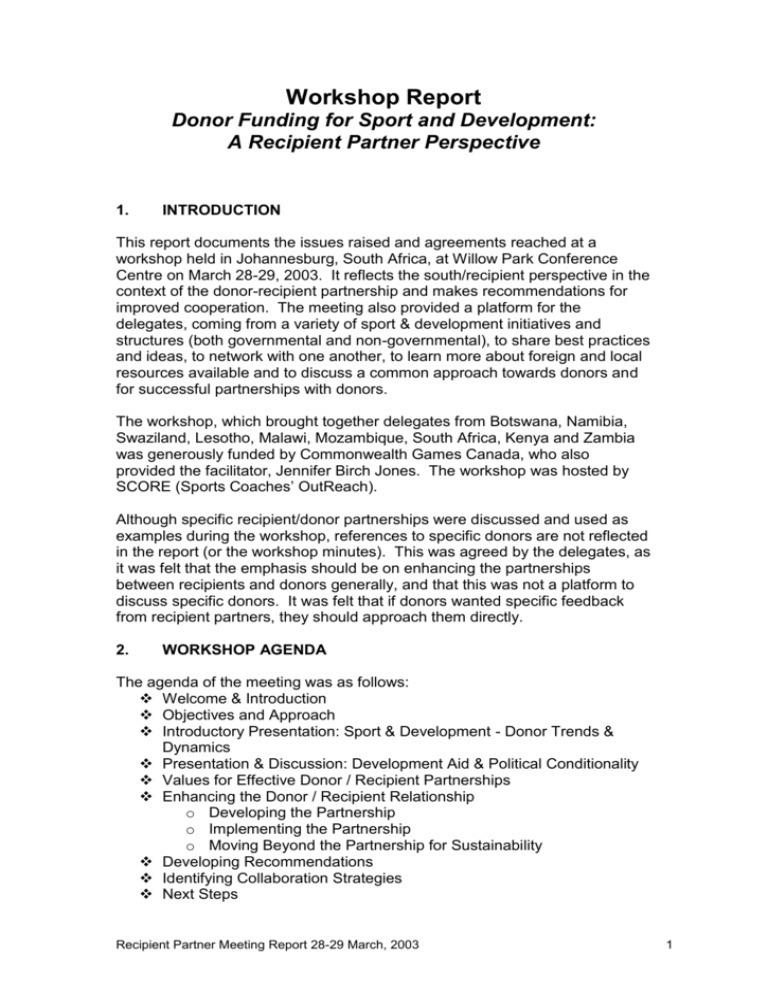
Workshop Report Donor Funding for Sport and Development: A Recipient Partner Perspective 1. INTRODUCTION This report documents the issues raised and agreements reached at a workshop held in Johannesburg, South Africa, at Willow Park Conference Centre on March 28-29, 2003. It reflects the south/recipient perspective in the context of the donor-recipient partnership and makes recommendations for improved cooperation. The meeting also provided a platform for the delegates, coming from a variety of sport & development initiatives and structures (both governmental and non-governmental), to share best practices and ideas, to network with one another, to learn more about foreign and local resources available and to discuss a common approach towards donors and for successful partnerships with donors. The workshop, which brought together delegates from Botswana, Namibia, Swaziland, Lesotho, Malawi, Mozambique, South Africa, Kenya and Zambia was generously funded by Commonwealth Games Canada, who also provided the facilitator, Jennifer Birch Jones. The workshop was hosted by SCORE (Sports Coaches’ OutReach). Although specific recipient/donor partnerships were discussed and used as examples during the workshop, references to specific donors are not reflected in the report (or the workshop minutes). This was agreed by the delegates, as it was felt that the emphasis should be on enhancing the partnerships between recipients and donors generally, and that this was not a platform to discuss specific donors. It was felt that if donors wanted specific feedback from recipient partners, they should approach them directly. 2. WORKSHOP AGENDA The agenda of the meeting was as follows: Welcome & Introduction Objectives and Approach Introductory Presentation: Sport & Development - Donor Trends & Dynamics Presentation & Discussion: Development Aid & Political Conditionality Values for Effective Donor / Recipient Partnerships Enhancing the Donor / Recipient Relationship o Developing the Partnership o Implementing the Partnership o Moving Beyond the Partnership for Sustainability Developing Recommendations Identifying Collaboration Strategies Next Steps Recipient Partner Meeting Report 28-29 March, 2003 1 3. WORKSHOP OBJECTIVES The following objectives were agreed for the workshop: Increased awareness and understanding of what is happening in Zone VI/SADC in initiatives using sport as a means of development Increased awareness and understanding of what is happening in Zone VI/SADC in terms of donor funding for sport and development Consensus on the values for effective donor and recipient partnerships Increased awareness and understanding of strategies to enhance the donor and recipient partnership o Developing the Partnership o Implementing the Partnership o Moving Beyond the Partnership for Sustainability Consensus on recommendations for enhancing the donor and recipient relationships in each of the 3 key phases of partnership Identification of and commitment to strategies for continued collaboration Understanding of next steps 4. DONOR FUNDING AND POLITICAL CONDITIONALITY Ms. Elizabeth Marabwa from the University of the Witwatersrand gave a presentation on the changing politics of the donor-recipient relationship, thereby providing an interesting backdrop for the discussions that followed. The following pertinent points were noted: Recipients should realize their need to change, become more professional, more self-confident, more open, and clearer about what they want and need. There needs to be a more equal partnership between donors and recipients. Organizations must not be blinded by the prospect of funding, but must consider the funding they are accepting carefully. Recipients must be able to produce the results the donors expect. Recipients must also not just take on projects simply for the money. Recipient and donor agreement on priorities is crucial. It is good practice to meet the donor at their head office, even though this might have financial implications. This could promote better relations & communication between donors and recipients, but also – importantly - provides a more equal platform for cooperation. The more focused an organisation is on its priorities, the better the chances are of the organization appealing to donors. At times, refusing funding from a donor organisation whose objectives one cannot fulfill, could result in the recipient organisation gaining respect and attracting more funding. The term ‘partnership’ should be used instead of ‘donor-recipient’, as the latter term has the negative connotation of ‘policing’. Partnership Recipient Partner Meeting Report 28-29 March, 2003 2 relates to the concept of feeling part of an initiative, rather than controlling an initiative. Recipients should be aware that there would be situations where donors will point out things worth improving. True partnership can only work if recipients are open to suggestions and change. Tension can arise when recipients & donors do not understand one another; donors and recipients may have similar priorities but may differ in understanding. An audience can help to establish clarity. Donor credibility is very important. For example, in South Africa SANGOCO has profiled and circulated a list of credible donors to recipients and vice versa. Recipients should communicate more with one another about different donors and become more informed about them and how they work. 5. VALUES FOR EFFECTIVE DONOR-RECIPIENT PARTNERSHIPS The delegates agreed to the following values, which they felt should form the foundation for any partnership or agreement between recipients and donors, and should be agreed upon prior to developing such a partnership: We believe in a partnership between recipients and donors that is based on the following values: 1) Mutual respect for both partners in which there is understanding and respect for each partners’ respective cultures, beliefs and backgrounds the conditions, priorities and perspectives of each partner the equal contribution each partner has to make to the success of the project shared ownership of the project the challenges and constraints within which partners operate, including effecting change with development through sport (recipients) and the realities of dealing with political masters (donors) 2) Transparency and open communication between partners in which: There is a clear understanding of each partner’s objectives and constraints and there are no hidden agendas Partners say what they mean There is honest dialogue between partners about each other’s financial budgets, what is being done and is not being done, and what is working, and is not working Dialogue occurs throughout the project, not just the initial phase, and involves face-to-face, as well as other means of communication 3) Accountability for results between partners in which: The project is based on a sound needs assessment and planning process that involves all partners Recipient Partner Meeting Report 28-29 March, 2003 3 There are agreed upon, clear goals which are achievable with the resources available and within the timeframe of the project There is a plan in place to implement the project, as well as to measure and report on the project’s success Timelines for financial milestones, key activities, and results reporting are adhered to Resources are used for the agreed upon results, and there is honest accounting for these resources There is shared accountability for success and failure 3) Professionalism and commitment to excellence by partners in which: There is a high quality service delivered to clients and to partners There is support for capacity-building to achieve high standards There is good governance through efficient and effective management practices, including good accounting systems Planning and results reporting are outcomes- based Conflicts are resolved through appropriate mechanisms, including alternate dispute resolution and arbitration 5) Flexibility and adaptability by partners in which: There is sensitivity to the dynamic nature of the immediate need Adaptations are allowed that will address changing needs while still achieving overall goals 4) Sustained commitment by partners in which: There is a multi-year commitment to affect lasting positive change There is recognition of the need for capacity building to achieve lasting project sustainability There is continued support for both successes and failures, and collaboration on solutions and ways to make the project better Promises are delivered on, words are kept, and agreements are honored We believe that by putting these values into action and achieving our shared results, partners will be empowered and trust will be strengthened. 6. DEVELOPMENT OF THE DONOR-RECIPIENT PARTNERSHIP The delegates discussed examples of what was working effectively, what was not working and what changes should be made in the initial stages of developing and formulating the donor-recipient partnership (up to the signing of an agreement). 6.1 Partnership Development: Examples of Good Practice a) All information about requirements is clear & procedures of the donor are well spelt out from the beginning Recipient Partner Meeting Report 28-29 March, 2003 4 b) Funds are available for an initial assessment & to formulate the proposal (with assistance from a consultant), and opportunities are given for partners to critique and give feedback on the assessment report c) The donor provides constructive feedback and assistance in the proposal writing process to the recipient d) Workshop(s) are organised with all partners & role players (including donor) to conceptualise the project; it is also effective to have workshops/meetings with politicians & senior decision makers as well as with implementers e) Partnerships between north & south NGO’s f) The donor allows the recipient to seek additional funding partners for the same project g) The donor gives a long-term commitment to the project (3-5 years) up front (this assists in the design); also effective when there is agreement up front on terms for flexibility in the project & budget to allow adjustments during implementation h) The donor shares clear information on what they can fund and the recipient can find a match with what they want to do i) There is multiple donor collaboration on a project, pooling resources j) The project falls within a broader bilateral agreement k) Recipients are included in a donor partner’s strategic planning process 6.2 Partnership Development: Problems Encountered a) Lack of donor transparency in terms of budgets and financial plans; recipient organization does not know what the budget is/will be or when funds will be transferred. b) Different levels of personal commitment and passion about the project between recipients and donors c) Bureaucracy, especially experienced with government and the larger donors; ie. when there are too many rules, procedures, conditions. There are also problems when donor partner’s system is imposed on the recipient organization, causing the recipient to adjust their internal systems. In a situation of multiple donor partners the problem multiplies. d) A donor who does not have the relevant expertise, knowledge or understanding when formulating the project, or does not demonstrate an openness to learn or change his/her view as a result of feedback from the recipient (recipient usually knows best what the needs are). e) The government is the intermediary in the development of a project between other organizations/NGOs (bureaucracy, other agendas, politics) f) There is no thorough needs assessment and projects are formulated over distance without face-to-face meetings and discussion. It was also found problematic when there was no Recipient Partner Meeting Report 28-29 March, 2003 5 g) h) i) j) 6.3 recipient perspective on the feasibility study team (ie. a local consultant). The community and partners do not “own” the proposed project, because it is driven by a donor’s agenda, or because consultation was not thorough enough (donor timetable), or because all role players were not involved from the beginning Lack of recipient partner strategic planning; not giving donors a clear indication of recipient partner’s objectives, priorities & future plans The partner and recipient timetables for planning or implementation do not match or are not agreed. There is no real agreement on the objectives and priorities, agreement is ‘achieved’ in order to expedite project implementation/delivery; different partner’s input is valued differently Recommended Changes: Development of the Donor-Recipient Partnership The agreed upon Recommended Changes for Enhancing the Development of the Partnership is as follows: 1. 2. 3. 4. 5. 6. 7. 8. 9. 10. 11. 12. There is a thorough needs assessment that Includes all partners Examines the project, the needs, local and non-local resources/expertise available Risks to success Stakeholders are involved in the formulation of bi-laterals. Partners define clearly and agree upon expected results and indicators for success, time frame for their achievement and strategies to minimize risks. There is face-to-face discussion with all partners (essential). Ownership and roles and responsibilities are clearly defined before signing agreement. Values are shared and agreed upon first as they form basis for cooperation. Each partner shares their long-term strategic plan and priorities. There is a business/operational plan that includes real capacity building for short-term success and long-term sustainability. There is a reference check conducted on the partners. Agreements are clear and understandable to both partners. Capacity is built for successful program delivery by providing initial resources (seed money) to conduct needs assessment, design/plan program, develop a measurement and evaluation strategy and write the proposal. Financial commitments are clearly defined and honoured. Recipient Partner Meeting Report 28-29 March, 2003 6 7. IMPLEMENTING THE DONOR-RECIPIENT PARTNERSHIP The delegates discussed examples of what was working effectively, what was not working and what changes should be made in the implementation phase of the donor-recipient partnership, ie: the project. 7.1 Implementation: Examples of Good Practice a) There are regular face-to-face partner meetings & donor visits (for on-site consultation) b) There is frequent, open communication/dialogue between the partners c) There is regular review of the agreement and project by the partners during implementation (internal and external assessments). Most effective when there is joint monitoring and evaluation (not done by only one partner) d) The donor and recipient share responsibilities as partners in the implementation of the project (ie. not just donor giving money) e) There is regular transfer of funds according to the agreed timetable f) There is a clear implementation & delivery plan, and the ability to monitor progress and results, which are captured in regular reports g) The donor acts as an advocate for the project to get other donors involved, thereby strengthening the project h) Changes to the project are suggested rather than imposed; ie. when there is proper consultation on any changes i) The donor partner assists with the reporting process (understanding formats, etc.) j) The donor recognizes a well-implemented program 7.2 Implementation: Problems Encountered a) Inadequate support for operations & infrastructure (unrealistic expectations of recipient partner performance in administration and operations systems, given the lack of resources) b) Disbursements are not according to plan and there is no explanation given by the donor c) Human resources (eg. volunteers, specialized coaches) are provided without adequate support (given or existing already) for their projects d) People with incorrect/inadequate skills are sent by donors as technical assistants, consultants or volunteers & local expertise is underestimated. e) Changing report formats and procedures during the project f) Little or no flexibility to make changes in the project arising out of lessons learned during implementation Recipient Partner Meeting Report 28-29 March, 2003 7 g) Time restrictions on projects determined by donors (eg. inflexible volunteer periods) and not by recipients/project implementers h) The donor considers discontinuing support the first time things seem not to be working or a problem arises, without proper (on site) investigation and consultation with the recipient i) Short term projects often do not work well; limited impact, too often not development-orientated j) Changes during implementation: for example, the project is suddenly changed from long term to short term by the donor partner, the donor suddenly reduces the budget when the project is already underway, the project is terminated suddenly because the technical assistant refused to follow local needs/instructions. It is problematic when there is little or no consultation prior to changes made to agreements or projects k) Changes in personnel during the process, which results in instability, lack of continuity l) Political intervention during the project, without respect for the agreement or the (recipient) partner’s constituency m) Recipients do not report on resources and results as agreed (late reports, incorrect format) n) Donors spend too much money on visits; money could go to the project o) The donor, with expectations for immediate results, does not take into account delays in project approval will impact on implementation and plans p) Donors ask that the recipient partner spend money to accommodate donor year-end financial reporting (may not suit recipient or project implementation process) q) Recipient uses money for other than agreed upon activities/expenses and is not forthright about this r) Donor restrictions on purchasing & procurement options s) Donor switches priorities and funds new projects according to trends, resulting in reduction of funds for existing programs or necessitating changes in projects to suit donor’s new priorities 7.3 Recommended Changes: Implementing the Donor-Recipient Partnership The agreed upon Recommended Changes for Enhancing Implementation of the Partnership are as follows: 1. Consultation must occur with all partners on changes to the agreement with reference to: Procedures Communication Time table Implementation process Budget Recipient Partner Meeting Report 28-29 March, 2003 8 2. 3. 4. 5. 6. 7. 8. 8. Ownership And that these key areas be frequently reviewed and assessed by both partners. Clear guidelines should be set in terms of project accountability, including financial management and reporting. Resources for capacity building must be included in the budget to ensure sustainability throughout the implementation phase. Resources should be made available to cater for the following critical needs: Human Facilities Equipment (IT) Avoiding duplication by utilizing the available resources and expertise within the region. Allowing flexibility in the design and implementation of the program, to reflect new realities. Frequent consultation with partners during the strategic planning and the project delivery phases to ensure increased transparency. Ongoing performance measurement and reporting is carried out by the recipient, and third party independent expertise is utilized for periodic third party evaluation. MOVING BEYOND PARTNERSHIPS TO SUSTAINABILITY The delegates discussed examples of what was working effectively, what was not working and what changes should be made in the last phase of the donorrecipient partnership & project, namely the sustainability/exit strategy phase. 8.1 Sustainability: Examples of Good Practice a) Capacity building & training within the implementing organization to continue the project and/or build on it; ie. funding is allocated within the project to train staff (general and specific skills). This is done from the beginning of the project. It was felt that even contract staff should be made more employable by the project and should receive access to training. b) New opportunities are created on the foundation of the present project, eg. new projects, new organizations arising c) Capital investments are made & the implementing organisation’s infrastructure is built up to support future projects and reduce dependence (eg. vehicles, facilities, computers, equipment) d) Recipient organisation planning early for sustainability & the donor’s exit; best when recipient plans together with the donor. e) New partnerships and networks created to share resources f) Increased utilisation of local/regional resources, including support by local funders (funders attracted by an established product and low setup costs) g) Use of project expertise as consultancy, to spread good practices and generate income Recipient Partner Meeting Report 28-29 March, 2003 9 h) General promotion of income-generating activities & support for fundraising within the recipient partner organisation i) Development of role models who encourage sustainability on the part of individuals involved (especially beneficiaries) 8.2 Sustainability: Problems Encountered a) Recipient must return interest and unspent funds & cannot build up own reserves b) Changes in the project mid-way during implementation threaten project focus & sustainability c) Staff & organizational changes during implementation, lack of continuity affects ultimate sustainability d) As the donor partner reduces the budget over time so the understudy must take over the project management – but often without the same resources which were used to set up the project (donor budget declines along same time-line); this can set up the understudy for failure e) Perpetual management of projects by foreign technical assistants f) Unqualified personnel (within organizations and sent from outside), do not achieve objectives within project timeframes. g) No investment in new skills/ideas to generate income h) Over-dependency on donors on the part of the recipients, instead of taking ownership of the sustainability issues i) Lack of proper consultation with beneficiaries - to prepare for end of project funding j) Political interference (local & international) k) Lack of recipient organization capacity to continue l) Conflict, power struggles, lack of unity (within organizations, between different organizations/stakeholders) m) Complacency in planning and strategizing for sustainability; no exit strategy n) Misunderstandings (especially amongst beneficiaries) on the role of volunteers or technical assistants 8.3 Recommended Changes: Moving Beyond Partnership to Sustainability The agreed upon Recommended Changes for Enhancing Moving Beyond Partnership for Sustainability are as follows: 1. Ensure shared values and vision from the start-within and between partners. 2. Develop clear, realistic, comprehensive plans for the project. Focus on quality outputs not quantity. Reject the project if there is lack of sufficient capacity to implement or sustain the project. Ensure project integration in longer term partner strategies Recipient Partner Meeting Report 28-29 March, 2003 10 3. Ensure a clear understanding of the roles of volunteers/interns and how they contribute to sustainability. 4. Include a sustainability strategy and plan in the initial project design. Define sustainability and what outcomes should be sustainable. Include target group in project design. Develop minimum standards (e.g. for volunteers) Plan for continual evaluation especially of longer-term project viability and understudy performance. Develop a financial plan for donor exit that clearly defines the length of donor involvement. 5. Diversify income sources and encourage joint funding. 6. Build and enhance networks especially local and regional, to share resources. 7. Build the case for sport (benefits, etc.) 8. Build capacity for implementing the partner to sustain the project activities Human resource training (management skills, fundraising skills, make temp. workers more employable) Develop expertise and capacity in fundraising and income generation. Set aside specific funds (in grant) for income-generation, fundraising, start up capital for new ideas. Invest in building organisational infrastructure. Contribute to building a capital base. Donors to consider rewarding good performance and efforts made to achieve sustainability. 9. Invest in local capacity building and strengthen local co-ordinating structures Include community in regular evaluation and planning 10. Utilise outputs and successes to generate more interest and support Include a PR plan (and funds) in project design Market project throughout -locally, regionally, nationally, and internationally. Sell expertise, service and intellectual capital to generate income (ensure protection of intellectual property) Develop and invest in role models. 9. RECIPIENT STRATEGIES FOR CONTINUED COLLABORATION The following strategies were identified as a means for continuing the collaboration of the recipient development through sport community: Encourage such meetings of the recipient group regularly o To share expertise, lessons learned and best practices o To network o To discuss or build capacity in certain areas of common need or interest Recipient Partner Meeting Report 28-29 March, 2003 11 Create a databank of information to share and share each other’s databank information Communicate via e-mail; share newsletters and other information through web sites & bulletins Share information about important events (eg. international conferences) – so people can attend and so people stay updated Hold regular competitions between youth of all the involved countries which could also provide a forum for discussions Utilise each other’s expertise o To build capacity o To implement programs more effectively o To support one another o To encourage regional cooperation. 10. CONCLUSION The participants felt that this was a very worthwhile workshop. It was hoped that these deliberations would provide an indication of recipient needs and challenges, which should continue to be addressed in discussion with donor partners, to create stronger, more effective projects and partnerships. There also was general consensus that this workshop should be the beginning of a more comprehensive process towards closer cooperation in the Southern African (Zone VI/SADC) region. Recipient Partner Meeting Report 28-29 March, 2003 12

